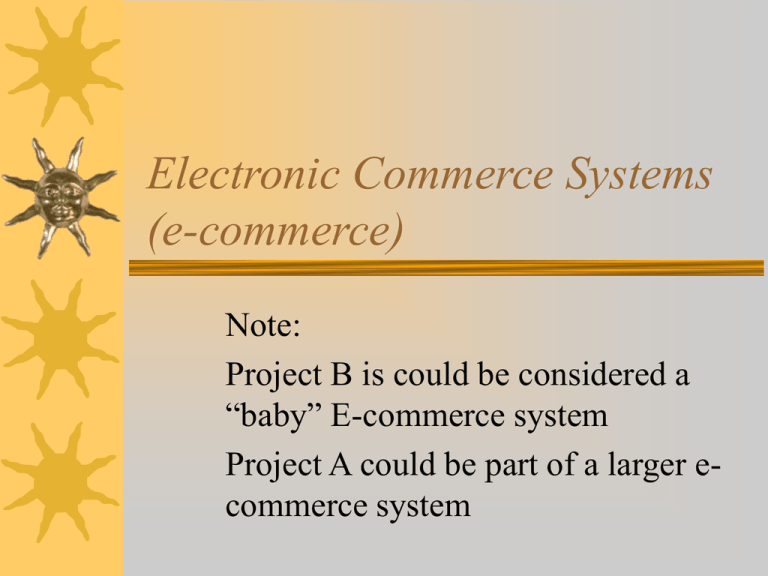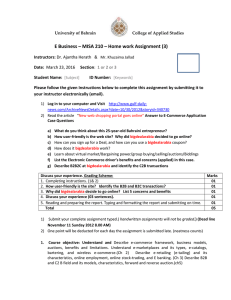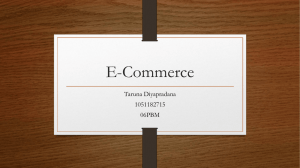What is Electronic Commerce?
advertisement

Electronic Commerce Systems (e-commerce) Note: Project B is could be considered a “baby” E-commerce system Project A could be part of a larger ecommerce system What you need to know about e-commerce Major categories and trends of e-commerce applications. Essential processes of an e-commerce Examples of how these process are implemented in e-commerce applications. What you need to know about e-commerce Web store requirements needed to succeed in e-commerce. Business value of several types of e- commerce marketplaces. Benefits and trade-offs of e-commerce clicks and bricks alternatives. What is Electronic Commerce? Encompasses the entire online process of developing, marketing, selling, delivering, servicing, and paying for products and services Transacted on internetworked, global marketplaces of customers, with the support of a worldwide network of business partners. Case #1: Success in an Online Marketplace Evolution of eBay: – Consumer auction market for small segment of population to sell collectibles – 30 million users listing 12 million items daily with own laws, feedback system, enforcement, payment processing unit Case #1: Success in an Online Marketplace Reasons for Success: – Voice of the Customer program – Customer take initiative to expand eBay economy • Industrial products marketplace • e-Bay motors • Wholesale business Case #1: Success in an Online Marketplace Why has eBay become such a successful and diverse online marketplace? Is E-bay’s move from C2C to B2C and B2B a good long-term strategy? Scope of e-Commerce Categories of e-Commerce Business-to-Consumer (B2C) – businesses develop attractive electronic marketplaces to sell products and services to consumers Business-to-Business (B2B) – involves both electronic business marketplaces and direct market links between businesses Consumer-to-Consumer (C2C) – includes auction websites and electronic personal advertising Essential e-Commerce Processes Access Control and Security E-commerce processes must establish mutual trust and secure access between the parties in an e-commerce transaction – by authenticating users, – authorizing access, and – enforcing security features Profiling and Personalizing Processes that gather data on you and your website behavior and choices, and build electronic profiles of your characteristics and preferences. These profiles are then used to recognize you as an individual user and provide you with a personalized view of the contents of the site, as well as product recommendations and personalized Web advertising Search Management Efficient and effective search processes provide a top e-commerce website capability that helps customers find the specific product or service they want to evaluate or buy Content and Catalog Management Content Management – software that helps e-commerce companies develop, generate, deliver, update, and archive text data and multimedia information at e-commerce websites Catalog Management – software that helps generate and manage catalog content Workflow Management Software that helps employees electronically collaborate to accomplish structured work tasks within knowledgebased business processes Event Notification Software that notifies customers, suppliers, employees, and other stakeholders of their status in a transaction based on events initiated by one of the parties Collaboration and Trading Processes that support the vital collaboration arrangements and trading services needed by customers, suppliers, and other stakeholders Electronic Payment Processes Web Payment – credit card payment processes on the web Electronic Funds Transfer (EFT) –money and credit transfers between banks and businesses and their customers Secure Electronic Payments – – encrypting data passing between customer and merchant – encrypting data passing between customer and company authorizing the credit card transaction, – taking sensitive information off-line Case #2: Lean Manufacturing Lean manufacturing is a methodology that seeks to eliminate all waste from the manufacturing process. The goal is to create a production environment driven by demand that holds only a small amount of inventory and products at any given time Case #2: Lean Manufacturing Modern Practices Employed: Just-in-time processes ensure that goods arrive when needed for production Kaizen calls on everyone to look for ways to improve quality, cycle times, safety and other aspects of an operation Kanban establishes a pull instead of a push system of moving goods through the factory Case #2: Lean Manufacturing 1. Does a company’s size have an effect on the advantage gained from lean manufacturing and integrations of the various procurement systems? 2. What are some of the specific way that Ecommerce facilitates Lean Manufacturing? e-Commerce Trends Business-to-Consumer e-Commerce e-Commerce Success Factors Selection and Value – attractive product selections, competitive prices, satisfaction guarantees, and customer support after the sale Performance and Service – fast, easy navigation, shopping, and purchasing, and prompt shipping and delivery e-Commerce Success Factors Look and Feel – attractive web storefront, website shipping areas, multimedia product catalog pages, and shopping features Advertising and Incentives – targeted web page advertising and e-mail promotions, discounts and special offers, including advertising at affiliate sites e-Commerce Success Factors Personal Attention – personal web pages, personalized product recommendations, Web advertising and e-mail notices, and interactive support for all customers Community Relationships – virtual communities of customers, suppliers, company representatives, and others via newsgroups, chat rooms, and links to related sites e-Commerce Success Factors Security and Reliability – security of customer information and website transactions, trustworthy product information, and reliable order fulfillment Web Store Requirements Developing a Web Store Build website using simple website design tools Market website to attract visitors and transform them into loyal Web customers Serving Customers Serve customers by creating user profiles, customer files, and promotions that develop a one-to-one relationship Transact with customers by providing dynamically changing catalog, fast catalog search engine, and shopping cart system integrated with promotions, payment, shipping, and account information Support customers with help menus, tutorials, FAQs and e-mail correspondence with customer service representatives Managing a Web Store Manage both the business and the website Operate twenty-four hours a day, seven days a week Protect Web store transactions and customer records, and repel hacker attacks and other security threats Business-to-Business eCommerce B2B e-commerce is the wholesale and supply side of the commercial process, where businesses buy, sell, or trade with other businesses. All factors for building a successful retail website also apply to wholesale websites for B2B e-commerce. e-Commerce Portals Definition: Websites developed and hosted by thirdparty market-maker companies who serve as infomediaries that bring buyers and sellers together in catalog, exchange, and auction markets. B2B e-Commerce Web Portal Infomediaries Definition: Companies that serve as intermediaries in e-business and e-commerce transactions Provide e-commerce marketplace software products and services to power business Web portals for e-commerce transactions Clicks and Bricks in eCommerce Summary Electronic commerce encompasses the entire online process of developing, marketing, selling, delivering, servicing, and paying for products and services. The basic categories of e-commerce include B2C, B2B and C2C. Summary Many e-business enterprises are moving toward offering full service B2C and B2B e-commerce portals supported by – integrated customer-focused processes and – internetworked supply chains. Summary Businesses typically sell products and services to consumers at e-commerce websites that provide – – – – – attractive Web pages, multimedia catalogs, interactive order processing, secure electronic payment systems, and online customer support. Summary Business-to-business applications of e- commerce involve – electronic catalog, exchange, and auction marketplaces that use Internet, intranet, and extranet websites and portals to unite buyers and sellers.







